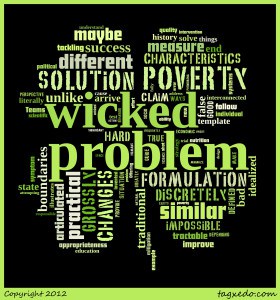[av_one_full first min_height=” vertical_alignment=” space=” custom_margin=” margin=’0px’ padding=’0px’ border=” border_color=” radius=’0px’ background_color=” src=” background_position=’top left’ background_repeat=’no-repeat’ animation=”]
[av_textblock size=” font_color=” color=”]
Last week, we explored the Yin and Yang dynamics of strategy and execution.
Now, we start to unpack the strategy portion of this relationship.
[/av_textblock]
[/av_one_full]
[av_one_half first min_height=” vertical_alignment=” space=” custom_margin=” margin=’0px’ padding=’0px’ border=” border_color=” radius=’0px’ background_color=” src=” background_position=’top left’ background_repeat=’no-repeat’ animation=”]
[av_textblock size=” font_color=” color=”]
Many organizations approach strategic planning as an answer to a “tame” problem, however, companies fail to recognize that they often cannot develop future models of the complex environments in which they operate and therefore cannot effectively plan with these approaches.
CEOs admit that their strategic challenges cannot be overcome by analyzing more data, using program management processes or defining the problem more clearly (Camillus 2008). The wicked world befuddles planning “experts” when it fails to conforming to their well laid out plans (Levin 2001).
Organizations face four basic strategic challenges:
1. Challenges with known solutions that lie within the expertise and skill of the organization (this is the challenge most organizations THINK they are dealing with);
2. Challenges with known solutions that are outside the expertise and skill of the organization (this is the challenge organizations WANT to deal with if they find themselves outside of the first challenge);
3. Challenges with solutions that are complex and the outcomes of solutions are not knowable in advance (this is the challenge MOST organizations actually face); and,
4. Challenges in chaotic environments in which no cause and effect are perceivable (this is the challenge organizations FEAR).
We recommend that organizations work backwards from the worst case scenario towards the best case scenario, moving from the chaotic challenge to the known challenge, so as not to fall in the trap of believing the organization is in a “tame” environment instead of recognizing the “wicked” problem they confront.
Wicked problems have very distinct characteristics and if the CEO or the organization take the time to systematically consider each characteristic, specific strategies and processes can be used to meet the wicked problem challenge.
[/av_textblock]
[/av_one_half][av_one_half min_height=” vertical_alignment=” space=” custom_margin=” margin=’0px’ padding=’0px’ border=” border_color=” radius=’0px’ background_color=” src=” background_position=’top left’ background_repeat=’no-repeat’ animation=”]
[av_textblock size=” font_color=” color=”]

The 10 characteristics of a wicked problem are (Rittel & Webber, 1973):
1. There is no definitive formulation of a wicked problem: the formulation of the wicked problem generally is the problem;
2. Wicked problems have no stopping rule: math equations have a stopping point when the equation is solved, but wicked problems have no equation and therefore no stopping point;
3. Solutions to wicked problems are not true or false, but good or bad: wicked solutions are often expressed as good/bad, better/worse, satisfying or “good-enough”; wicked solutions often reveal or generate other problems or unintended or undesirable consequences;
4. There is no immediate and no ultimate test of a solution to a wicked problem: wicked solutions often reveal or generate other problems or unintended or undesirable consequences;
5. Every solution to a wicked problem is a “one-shot” operation: there is no way to “test” a wicked solution other than to “give it a go”;
6. Wicked problems do not have a describable set of potential solutions: there is no way to determine if all (or any) of the potential solution have been identified;
7. Every wicked problem is essentially unique;
8. Every wicked problem can be considered to be a symptom of another problem: wicked problems are Gordian knots of problems with no clear root causes;
9. The existence of a discrepancy representing a wicked problem can be explained in numerous ways: many stakeholders will have different ideas on the causes and solutions;
10. The planner has no right to be wrong: wicked solutions do not try to find “truth,” they only try to improve some of the conditions in the problem set.
By selecting Colman Coaching as your strategic coaching partner, you are choosing a top performer in the leadership development space, specializing in executive development and corporate performance.
Whether you face a “wicked” or “tame” challenge, we will help you find your way ahead to personal and professional success.
Next week, Setting Your Strategic Course.
References
Camillus, J. C. (2008). Strategy as a wicked problem. Harvard Business Review, 86(5), 98. Retrieved from Google Scholar.
Kurtz, C. F., & Snowden, D. J. (2003). The new dynamics of strategy: Sense-making in a complex and complicated world. IBM Systems Journal, 42(3), 462-483. Retrieved from Google Scholar.
Levin, Y. (2001). Tyranny of reason: The origins and consequences of the social scientific outlook. University Press of Amer. Retrieved from Google Scholar.
Rittel, H. W. J., & Webber, M. M. (1973). Dilemmas in a general theory of planning. Policy Sciences, 4(2), 155-169. Retrieved from Google Scholar.
[/av_textblock]
[/av_one_half][av_textblock size=” font_color=” color=”]
Click here to add your own text
[/av_textblock]

